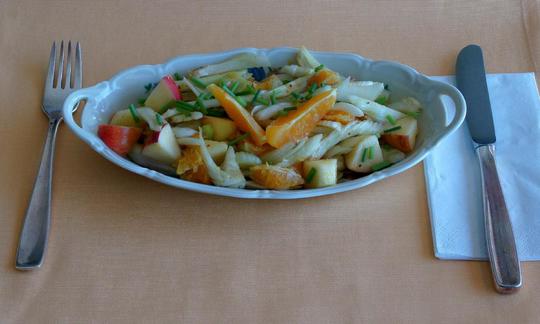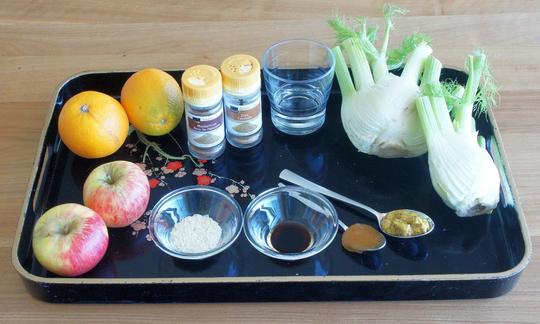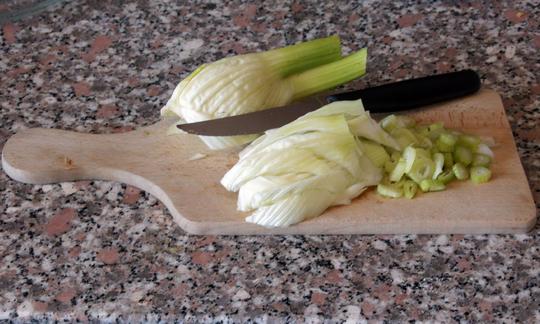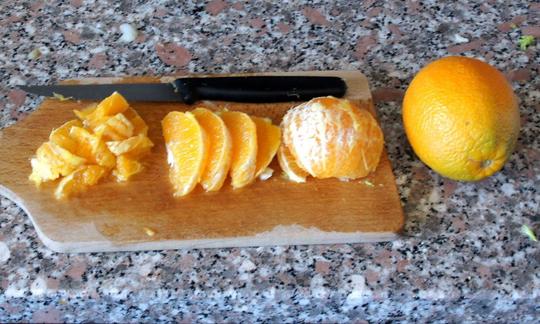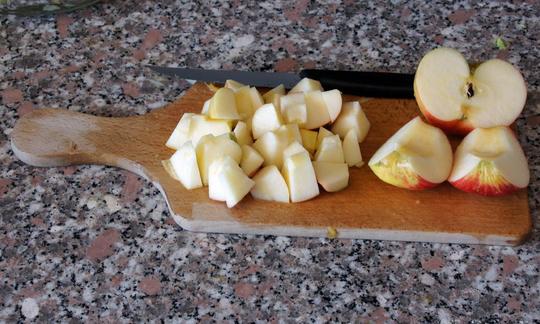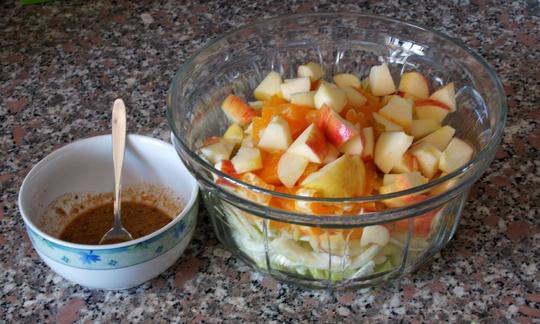Fennel salad with apples and oranges (fruity)
vegan
Ingredients (for servings, )
| For the salad | |
|---|---|
| 2 | Fennel (bulbs, raw, organic?) (20 oz) |
| 2 | Apples, raw, with peel (11 oz) |
| 2 | Oranges, raw, (organic?) (9.2 oz) |
| For the dressing | |
| 5 tbsp | Drinking water, raw (organic?) (1.0 oz) |
| 1 tsp | Nutmeg, ground or grated (raw, organic?) (0.08 oz) |
| 1 tsp | Reduced salt soy sauce (Genen-Shoyu, organic?, raw?) (0.19 oz) |
| 1 ½ tbsp | Mustard (Mostert, Mostrich, raw?, organic?) (0.66 oz) |
| 2 tbsp | Yeast flakes: noble yeast, nutritional yeast, yeast powder (raw?, organic?) (0.20 oz) |
| ½ tsp | Cinnamon (ground, raw, organic?) (0.05 oz) |
| 1 tbsp | Honey (bee honey, raw?, organic?) (0.74 oz) |
Type of preparation
- food preparation without heating
Preparation
For the salad
Wash the fennel and cut off the top of the stalk. Halve the bulbs in the middle and cut out the stalk. Then cut the fennel bulbs lengthways into thin strips. Cut the stalks into thin slices.Peel the oranges, fillet them and cut them into bite-sized pieces.
Tips for filleting oranges: To fillet oranges, first remove the top and bottom ends with a straight cut. Then place the orange on the cutting surface and separate the peel from the flesh with semicircular cuts. Now remove any remaining white skin and cut out the individual fillets along the white membranes.
Wash the apples, quarter them and cut out the cores. Cut the quartered apples into bite-sized pieces.
For the dressing
Pour tap water into a small bowl, add nutmeg, soy sauce, mustard, half of the yeast flakes, cinnamon and honey and stir well.Add the dressing and the other half of the nutritional yeast to the salad and mix well.
Arrange the finished "fennel salad with apples and oranges" on a plate and serve.
|
Nutritional Information per person
Convert per 100g
|
2000 kcal | |
|---|---|---|
| Energy | 143 kcal | 7.1% |
| Fat/Lipids | 0.90 g | 1.3% |
| Saturated Fats | 0.32 g | 1.6% |
| Carbohydrates (inc.dietary fiber) | 34 g | 12.7% |
| Sugars | 24 g | 26.6% |
| Fiber | 8.6 g | 34.6% |
| Protein/Albumin | 3.6 g | 7.3% |
| Cooking Salt (Na:170.1 mg) | 432 mg | 18.0% |
| Essential micronutrients with the highest proportions | per person | 2000 kcal | |
|---|---|---|---|
| Vit | Vitamin K | 92 µg | 122.0% |
| Vit | Vitamin C (ascorbic acid) | 56 mg | 69.0% |
| Vit | Vitamin B1 (Thiamine) | 0.67 mg | 61.0% |
| Elem | Potassium, K | 804 mg | 40.0% |
| Vit | Vitamin B9, B11 (Folate, as the active form of folic acid) | 66 µg | 33.0% |
| Sodium, Na | 170 mg | 21.0% | |
| Min | Manganese, Mn | 0.41 mg | 21.0% |
| Min | Copper, Cu | 0.16 mg | 16.0% |
| Elem | Calcium, Ca | 111 mg | 14.0% |
| Elem | Phosphorus, P | 96 mg | 14.0% |
Detailed Nutritional Information per Person for this Recipe
The majority of the nutritional information comes from the USDA (US Department of Agriculture). This means that the information for natural products is often incomplete or only given within broader categories, whereas in most cases products made from these have more complete information displayed.
If we take flaxseed, for example, the important essential amino acid ALA (omega-3) is only included in an overarching category whereas for flaxseed oil ALA is listed specifically. In time, we will be able to change this, but it will require a lot of work. An “i” appears behind ingredients that have been adjusted and an explanation appears when you hover over this symbol.
For Erb Muesli, the original calculations resulted in 48 % of the daily requirement of ALA — but with the correction, we see that the muesli actually covers >100 % of the necessary recommendation for the omega-3 fatty acid ALA. Our goal is to eventually be able to compare the nutritional value of our recipes with those that are used in conventional western lifestyles.
| Essential fatty acids | per person | 2000 kcal |
|---|---|---|
| Linoleic acid; LA; 18:2 omega-6 | 0.30 g | 3.0% |
| Alpha-Linolenic acid; ALA; 18:3 omega-3 | 0.03 g | 1.0% |
| Essential amino acids | per person | 2000 kcal |
|---|---|---|
| Tryptophan (Trp, W) | 0.01 g | 3.0% |
| Lysine (Lys, K, irreversibly transaminated) | 0.05 g | 3.0% |
| Valin (Val, V) | 0.04 g | 3.0% |
| Threonine (Thr, T, irreversibly transaminated) | 0.02 g | 2.0% |
| Isoleucine (Ile, I) | 0.03 g | 2.0% |
| Leucine (Leu, L) | 0.04 g | 2.0% |
| Methionine (Met, M) | 0.02 g | 2.0% |
| Phenylalanine (Phe, F) | 0.03 g | 2.0% |
| Vitamins | per person | 2000 kcal |
|---|---|---|
| Vitamin K | 92 µg | 122.0% |
| Vitamin C (ascorbic acid) | 56 mg | 69.0% |
| Vitamin B1 (Thiamine) | 0.67 mg | 61.0% |
| Vitamin B9, B11 (Folate, as the active form of folic acid) | 66 µg | 33.0% |
| Vitamin B6 (pyridoxine) | 0.18 mg | 13.0% |
| Vitamin B2 (Riboflavin) | 0.15 mg | 11.0% |
| Vitamin B5 (Pantothenic acid) | 0.65 mg | 11.0% |
| Vitamin B3 (Niacin) | 1.5 mg | 10.0% |
| Vitamin A, as RAE | 78 µg | 10.0% |
| Vitamin B7 (Biotin, ex vitamin H) | 5.1 µg | 10.0% |
| Vitamin E, as a-TEs | 1.1 mg | 9.0% |
| Essential macroelements (macronutrients) | per person | 2000 kcal |
|---|---|---|
| Potassium, K | 804 mg | 40.0% |
| Sodium, Na | 170 mg | 21.0% |
| Calcium, Ca | 111 mg | 14.0% |
| Phosphorus, P | 96 mg | 14.0% |
| Magnesium, Mg | 41 mg | 11.0% |
| Essential trace elements (micronutrients) | per person | 2000 kcal |
|---|---|---|
| Manganese, Mn | 0.41 mg | 21.0% |
| Copper, Cu | 0.16 mg | 16.0% |
| Iron, Fe | 1.3 mg | 10.0% |
| Selenium, Se | 3.0 µg | 5.0% |
| Zinc, Zn | 0.42 mg | 4.0% |
| Iod, I (Jod, J) | 1.1 µg | 1.0% |
| Fluorine, F | 8.0 µg | < 0.1% |
Oranges and apples give the fresh fennel salad, which is suitable as a starter or main course, a pleasant fruity aroma.
Store fennel correctly: You can recognize fresh fennel by its firm, white to light green bulb. The green leaves should not have any wilted leaves. It is best to store fennel in the vegetable compartment of the refrigerator. Handle it carefully, then no brown bruises will appear. Make sure to wash the bulb very thoroughly. Sand is often found in the spaces between the leaves.
Bee honey: We use real bee honey in this recipe. This is still raw if it was produced by cold spinning. During storage and processing, temperatures of over 40 degrees Celsius cause a reduction in important, temperature-sensitive ingredients. The quality of the honey itself also depends on processing and storage, with the fructose-glucose ratio playing a decisive role here. Since a vegan diet is free of animal products and products for which animals are exploited, honey is strictly speaking not vegan. You can find more information under the ingredient honey.
We do not consider soy sauce to be a raw food . During the manufacturing process, the soybeans are usually heated because green beans of all kinds contain the glycoprotein phasin, which is toxic to humans. Phasin impairs the absorption of nutrients in the intestine, has a hemagglutinating effect (causes red blood cells to clump together) and can also destroy the intestinal villi in high doses. Heating processes (cooking, roasting, etc.) destroy phasin and thus make soybeans and products made from them such as tofu, miso or tempeh edible for humans. This means that even unpasteurized soy products are no longer actually raw food, but merely cooked food that has been "revived" through fermentation.
Dosage of nutmeg: The taste of nutmeg is delicately tart, fiery and slightly bitter. The nutmeg should only be added at the end as the aroma quickly evaporates. You only need a small pinch of freshly grated nutmeg to season food. Larger quantities should not be consumed as an adult can experience symptoms of poisoning if they consume just four grams of nutmeg. These can include headaches, nausea, loss of balance and sweating. Larger quantities of nutmeg can even lead to life-threatening symptoms of poisoning (severe delirium) in small children.
Use Ceylon cinnamon: It is recommended that you use Ceylon cinnamon when cooking, which you can buy in Asian shops, health food stores, pharmacies and drugstores. Although both Cassia cinnamon and Chinese cinnamon are cheaper, they contain coumarin, which is harmful to health in high doses.
Using orange peels: Leftover orange peels are great for decoration. If you use organic oranges, you can also use the peels directly as a tea infusion. The grated orange peel can also be used to refine desserts, sauces, soups and drinks.
Eat the apple peel: Apples are sometimes available in stores that have wax, pesticides or preservatives added to them. Fear of harmful substances causes many consumers to peel the apple before eating it. However, many vitamins and minerals are found directly in or under the peel. In addition, the fiber they contain stimulates digestion. This is why you should not peel apples, but only wash them thoroughly or rub them with a cloth. If you want to be on the safe side, you should choose organic products, as no pesticides are used in their production.
Make your own mustard paste: Mustard paste is easy to make yourself. The ingredients for 300 ml of mustard paste are: 75 g mustard seeds, 80-100 ml water (start with 80 ml and add more if the consistency is insufficient), 80 ml wine vinegar and salt. Now put the mustard seeds, vinegar and water in a container and mix everything with a hand blender until it forms a smooth paste. Add a little salt (1-2 pinches) and continue to blend until you get the desired consistency. Other variations include crushing/grinding the mustard seeds. You can also add a little honey (1-2 tsp).
Refine with herbs: You can refine the fennel salad with oranges and apples with various herbs as you like. Savory, thyme, tarragon and coriander are very suitable for this.
Alternative to fine yeast: Fine yeast (yeast flakes) is yeast (single-celled fungi) that has been inactivated by heat. It is first dried and then processed into small flakes. Fine yeast is used in the kitchen to season and thicken soups, sauces and salads with low sodium. It is also used to make vegetarian spreads and pies. Brewer's yeast can also be used as an alternative to fine yeast. The latter is also suitable as a raising agent, among other things. In contrast to brewer's yeast, however, the spicy taste of fine yeast is milder. Unlike baker's yeast, fine yeast is not suitable for fermenting beer, wine and vinegar.
Alternative to honey: As an alternative to honey, you can use agave syrup. This is a purely plant-based sweetener made from various types of agave. The taste is very similar to that of acacia honey, making it a good vegan substitute for honey.

